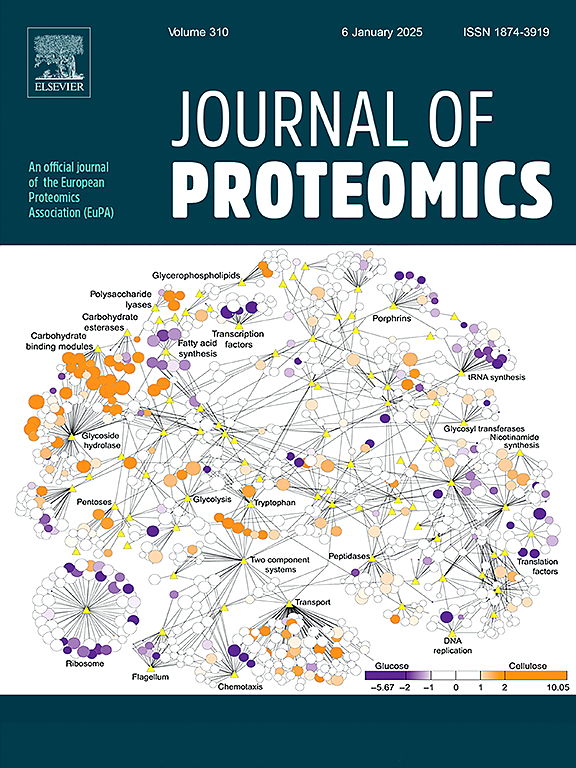A comprehensive proteomic analysis reveals novel inflammatory biomarkers in intracranial aneurysms
IF 2.8
2区 生物学
Q2 BIOCHEMICAL RESEARCH METHODS
引用次数: 0
Abstract
Inflammation is a complex factor in the pathogenesis of intracranial aneurysms (IA), but its specific cellular inflammatory factors remain uncertain. We collected two cohorts and measured the representation of vascular inflammation-related proteins using the Olink CVD II Vascular Inflammation Panel. We subsequently validated our findings using ELISA and RT-qPCR. Our proteomic analysis identified 11 vascular inflammation-related markers that were significantly differentially represented between the IA and control groups. These markers were implicated in leukocyte migration, immune response, triglyceride and lipoprotein metabolism, acute phase response, T cell regulation, and several key biological pathways, including PPAR, HIF-1, cytokine-cytokine interactions, and PI3K-AKT signaling. Further validation with ELISA and RT-qPCR confirmed the differential representation of IL6, PTX3, LPL, and OLR1 between the two groups. Notably, a combination marker incorporating these four factors demonstrated high diagnostic potential for the early detection of IA. Our study has identified a set of informative biomarkers (IL6, PTX3, LPL, and OLR1) that could be valuable for the early diagnosis of IA. Importantly, this is the first report of significantly elevated OLR1 representation in the plasma of IA patients. Further investigation into the role of OLR1 in the pathogenesis of IA is warranted.
Significance
This study significantly advances our understanding of the molecular mechanisms underlying intracranial aneurysm (IA) pathogenesis. By identifying a panel of novel biomarkers, including the previously unreported elevated expression of OLR1 in IA patients, we provide crucial insights into the inflammatory processes involved in aneurysm formation and development. These findings have important clinical implications, as the identified biomarkers could serve as valuable tools for early diagnosis and potentially targeted therapeutic interventions. Furthermore, the study highlights the complex interplay of inflammatory pathways in IA, suggesting that a multi-faceted approach may be necessary for effective management.

一项全面的蛋白质组学分析揭示了颅内动脉瘤中新的炎症生物标志物。
炎症是颅内动脉瘤发病的一个复杂因素,但其具体的细胞炎症因子尚不清楚。我们收集了两个队列,并使用Olink CVD II血管炎症小组测量了血管炎症相关蛋白的代表性。随后,我们使用ELISA和RT-qPCR验证了我们的发现。我们的蛋白质组学分析确定了11个血管炎症相关标记,在IA组和对照组之间存在显著差异。这些标志物涉及白细胞迁移、免疫反应、甘油三酯和脂蛋白代谢、急性期反应、T细胞调节和几个关键的生物学途径,包括PPAR、HIF-1、细胞因子-细胞因子相互作用和PI3K-AKT信号传导。ELISA和RT-qPCR进一步验证了两组之间IL6、PTX3、LPL和OLR1的差异表达。值得注意的是,结合这四个因素的组合标记物在IA的早期检测中显示出很高的诊断潜力。我们的研究已经确定了一组信息丰富的生物标志物(IL6, PTX3, LPL和OLR1),可能对IA的早期诊断有价值。重要的是,这是IA患者血浆中OLR1表达显著升高的首次报道。进一步研究OLR1在IA发病机制中的作用是必要的。意义:本研究显著推进了我们对颅内动脉瘤(IA)发病机制的分子机制的认识。通过鉴定一组新的生物标志物,包括先前未报道的IA患者中OLR1的升高表达,我们为动脉瘤形成和发展中涉及的炎症过程提供了重要的见解。这些发现具有重要的临床意义,因为确定的生物标志物可以作为早期诊断和潜在的靶向治疗干预的有价值的工具。此外,该研究强调了IA中炎症途径的复杂相互作用,表明有效治疗可能需要多方面的方法。
本文章由计算机程序翻译,如有差异,请以英文原文为准。
求助全文
约1分钟内获得全文
求助全文
来源期刊

Journal of proteomics
生物-生化研究方法
CiteScore
7.10
自引率
3.00%
发文量
227
审稿时长
73 days
期刊介绍:
Journal of Proteomics is aimed at protein scientists and analytical chemists in the field of proteomics, biomarker discovery, protein analytics, plant proteomics, microbial and animal proteomics, human studies, tissue imaging by mass spectrometry, non-conventional and non-model organism proteomics, and protein bioinformatics. The journal welcomes papers in new and upcoming areas such as metabolomics, genomics, systems biology, toxicogenomics, pharmacoproteomics.
Journal of Proteomics unifies both fundamental scientists and clinicians, and includes translational research. Suggestions for reviews, webinars and thematic issues are welcome.
 求助内容:
求助内容: 应助结果提醒方式:
应助结果提醒方式:


